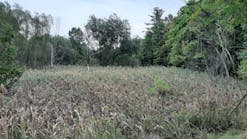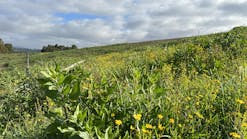Keeping Our Soil in Place with the Right Crop Rotation
Several management practices can reduce cropland erosion. A rough surface and/or shortening the length of the surface can contribute to reduced soil erosion. Crop barriers such as grass, crops, or trees along the prevailing wind direction can reduce potential wind erosion. For humid systems, vegetative barriers can also be used to reduce water runoff and increase infiltration. Vegetation and crop residue is the most effective way to protect against soil erosion since it maintains the soil cover and protects unsheltered particles. Conservation tillage is a system that leaves more than 30% of the surface area covered by residue. Among other management practices that contribute to soil and water conservation are minimum tillage, winter cover crops, elimination of summer fallow, no till, buffers, and several other practices discussed in more detail by several authors (Pierce and Frye, 1998; Lal, 1999).Irrigation can also contribute to moving fine particles and nutrients off the fields. New alternatives that are being used are the applications of polyacrylamide,1 a high-molecular-weight anionic long-chain organic polymer (Sojka and Lentz, 1997). These compounds have been tested and are widely used, reducing as much as 99% of the irrigated furrow erosion. Additional techniques that can be used to evaluate the effects of best management practices (BMPs) to reduce potential erosion include the use of new computer models. A series of simulation models has been developed to test the relationships between soil erosion and soil productivity, such as the Erosion Productivity Impact Calculator (EPIC) (Williams et al., 1983). This model has been developed, calibrated, and validated for several regions of the US.The US Department of Agriculture’s Natural Resources Conservation Service (USDA-NRCS) Resource Assessment Division used the Universal Soil Loss Equation (USLE) and the wind erosion equation (WEQ) to calculate wind, sheet, and rill erosion from cropland during 1997 (USDA-NRCS, 1999). The division estimated that 24.5 million ha of highly erodible land and 20.9 million ha of non—highly erodible land was eroding excessively for a total estimate of 1.2 billion megagrams (Mg) of erosion from US cropland. The USDA-NRCS data did not included information from federal lands, Alaska, the Pacific Basin, and Puerto Rico. Although there was a potential 1.2 billion Mg of erosion from cropland during 1997, the potential wind and water erosion from cropland and Conservation Reserve Program lands has been reduced in the US by almost 40% during the last 15 years (Figure 2). The mean sheet and rill erosion for cropland was decreased from 9.2 Mg ha-1 y-1 in 1982 to 6.3 in 1997. Similarly, the mean cropland rate of wind erosion was reduced from 7.4 Mg ha-1 y-1 in 1982 to 4.9 in 1997. The USDA-NRCS (1999) reported that this combined wind and water mean erosion reduction from 1982 to 1997 is equivalent to savings of 1.1 billion Mg of soil per year on cropland. These significant reductions in soil erosion achieved during the last 15 years have been the result of the implementation of BMPs that reduced the rate of erosion significantly across the nation. Although this is a great success story, there are still 45.4 million ha eroding excessively, and there is the need to continue improving research and developing new methods in the area of soil and water conservation to continue the transfer of new viable BMPs that can continue reducing this potential soil erosion.As an example of some of these efforts and cooperation, the USDA-ARS Soil Plant Nutrient Research Unit, USDA-NRCS, Colorado State University Research Center, Colorado State University Cooperative Extension, farmers, and private industry have cooperated since 1992 in soil and water-quality studies conducted across different cropping systems of south central Colorado. The typical rotation for this region is potato—small grain rotation. Such vegetables as lettuce or spinach, however, are also grown in rotation with small grains. Lettuce, spinach, and potato leave low quantities of surface-crop residue after harvesting. We studied the potential to use new crop rotations to reduce potential wind erosion in this region. Figure 3 shows the amount of minimum soil cover after harvesting potatoes, compared to how the system looks with stubble after harvesting small grain. For potatoes and small vegetables, the bare soil surface is highly susceptible to soil wind erosion (Figure 4). During the same windstorm, erosion from small-grain areas was minimal, almost not detected. Leaving the small-grain stubble undisturbed until spring when tillage operations could start would significantly reduce wind erosion. When winter-cover rye was planted between a lettuce-potato rotation, the losses of soil particles, organic matter, and nutrients were significantly reduced for the rotation (Figures 4 and 5). Similarly, if we plant winter wheat immediately after harvesting potatoes and don’t leave the soil fallow until the spring for planting of spring wheat, the potential soil erosion and losses of organic C (soil organic matter) and nutrients will also be significantly reduced for the rotation.





